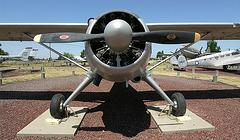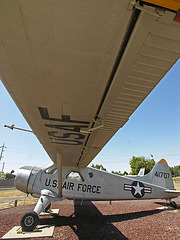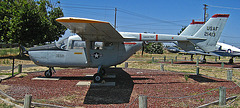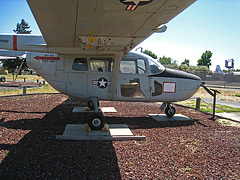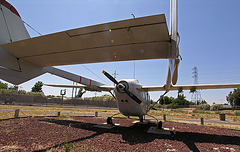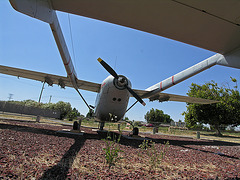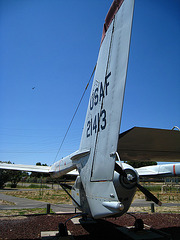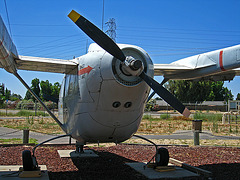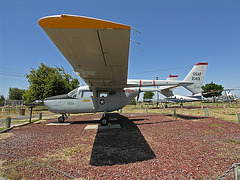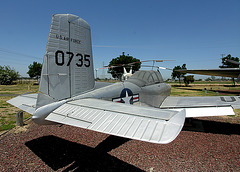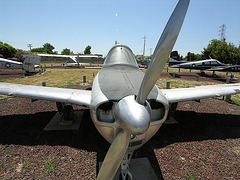
Castle Air Museum
A visit to the Castle Air Museum in Atwater, California.
DeHaviland-Canada L-20 Beaver (8386)
| |
|
Originally designed as a utility aircraft for service in Canada's rugged north, this plane was valued by both the U.S. Army and Air Force. The U.S. purchased some 980. It could be fitted with skis or floats and was used for observation and light transport duties. Though not very fast (155 MPH maximum), they were quick to get off the ground. A fully loaded L-20 could clear a 50 foot obstacle while using only 1,200 feet of runway. This plane at Castle Air Museum came from the Department of Agriculture.
DeHaviland-Canada L-20 Beaver (8385)
| |
|
Originally designed as a utility aircraft for service in Canada's rugged north, this plane was valued by both the U.S. Army and Air Force. The U.S. purchased some 980. It could be fitted with skis or floats and was used for observation and light transport duties. Though not very fast (155 MPH maximum), they were quick to get off the ground. A fully loaded L-20 could clear a 50 foot obstacle while using only 1,200 feet of runway. This plane at Castle Air Museum came from the Department of Agriculture.
DeHaviland-Canada L-20 Beaver (8387)
| |
|
Originally designed as a utility aircraft for service in Canada's rugged north, this plane was valued by both the U.S. Army and Air Force. The U.S. purchased some 980. It could be fitted with skis or floats and was used for observation and light transport duties. Though not very fast (155 MPH maximum), they were quick to get off the ground. A fully loaded L-20 could clear a 50 foot obstacle while using only 1,200 feet of runway. This plane at Castle Air Museum came from the Department of Agriculture.
Cessna O-2A Super Skymaster (3016)
| |
|
In 1967 the USAF needed a twin-engine forward observation aircraft in Vietnam. Cessna proposed its civilian model 337, then in production. Modifications for the military included pylons for smoke rockets, a smoke generator to make it more visible and a loud speaker in psychological warfare. This "A" version was used to locate enemy ground positions and downed American airmen. The pilot was a "forward air controller" who could call in fighter-bombers to hit the target he designated.
Cessna O-2A Super Skymaster (3017)
| |
|
In 1967 the USAF needed a twin-engine forward observation aircraft in Vietnam. Cessna proposed its civilian model 337, then in production. Modifications for the military included pylons for smoke rockets, a smoke generator to make it more visible and a loud speaker in psychological warfare. This "A" version was used to locate enemy ground positions and downed American airmen. The pilot was a "forward air controller" who could call in fighter-bombers to hit the target he designated.
Cessna O-2A Super Skymaster (8391)
| |
|
In 1967 the USAF needed a twin-engine forward observation aircraft in Vietnam. Cessna proposed its civilian model 337, then in production. Modifications for the military included pylons for smoke rockets, a smoke generator to make it more visible and a loud speaker in psychological warfare. This "A" version was used to locate enemy ground positions and downed American airmen. The pilot was a "forward air controller" who could call in fighter-bombers to hit the target he designated.
Cessna O-2A Super Skymaster (8392)
| |
|
In 1967 the USAF needed a twin-engine forward observation aircraft in Vietnam. Cessna proposed its civilian model 337, then in production. Modifications for the military included pylons for smoke rockets, a smoke generator to make it more visible and a loud speaker in psychological warfare. This "A" version was used to locate enemy ground positions and downed American airmen. The pilot was a "forward air controller" who could call in fighter-bombers to hit the target he designated.
Cessna O-2A Super Skymaster (3019)
| |
|
In 1967 the USAF needed a twin-engine forward observation aircraft in Vietnam. Cessna proposed its civilian model 337, then in production. Modifications for the military included pylons for smoke rockets, a smoke generator to make it more visible and a loud speaker in psychological warfare. This "A" version was used to locate enemy ground positions and downed American airmen. The pilot was a "forward air controller" who could call in fighter-bombers to hit the target he designated.
Cessna O-2A Super Skymaster (3018)
| |
|
In 1967 the USAF needed a twin-engine forward observation aircraft in Vietnam. Cessna proposed its civilian model 337, then in production. Modifications for the military included pylons for smoke rockets, a smoke generator to make it more visible and a loud speaker in psychological warfare. This "A" version was used to locate enemy ground positions and downed American airmen. The pilot was a "forward air controller" who could call in fighter-bombers to hit the target he designated.
Cessna O-2A Super Skymaster (8390)
| |
|
In 1967 the USAF needed a twin-engine forward observation aircraft in Vietnam. Cessna proposed its civilian model 337, then in production. Modifications for the military included pylons for smoke rockets, a smoke generator to make it more visible and a loud speaker in psychological warfare. This "A" version was used to locate enemy ground positions and downed American airmen. The pilot was a "forward air controller" who could call in fighter-bombers to hit the target he designated.
Cessna O-2A Super Skymaster (8389)
| |
|
In 1967 the USAF needed a twin-engine forward observation aircraft in Vietnam. Cessna proposed its civilian model 337, then in production. Modifications for the military included pylons for smoke rockets, a smoke generator to make it more visible and a loud speaker in psychological warfare. This "A" version was used to locate enemy ground positions and downed American airmen. The pilot was a "forward air controller" who could call in fighter-bombers to hit the target he designated.
Cessna O-2A Super Skymaster (8388)
| |
|
In 1967 the USAF needed a twin-engine forward observation aircraft in Vietnam. Cessna proposed its civilian model 337, then in production. Modifications for the military included pylons for smoke rockets, a smoke generator to make it more visible and a loud speaker in psychological warfare. This "A" version was used to locate enemy ground positions and downed American airmen. The pilot was a "forward air controller" who could call in fighter-bombers to hit the target he designated.
Functioning Water Fountain (8410)
| |
|
There are two drinking fountains on the grounds of the Castle Air Museum. Both are broken, but you can at least get water from this one.
Beech YT-34 Mentor (8403)
| |
|
This aircraft was a primary pilot trainer replacement for the T-6 Texan. Beginning in the early 1950s, it was used by both the USAF and the USN. It is an excellent aerobatic aircraft and can be seen at airshows This plane saw service at the three bases in Texas: Randolph, Goodfellow and James Connally. It has a maximum speed of 191 MPH and a ceiling of 20,000 feet. Some Navy T-34s were converted to more powerful turboprop engines, improving performance.
Beech YT-34 Mentor (8402)
| |
|
This aircraft was a primary pilot trainer replacement for the T-6 Texan. Beginning in the early 1950s, it was used by both the USAF and the USN. It is an excellent aerobatic aircraft and can be seen at airshows This plane saw service at the three bases in Texas: Randolph, Goodfellow and James Connally. It has a maximum speed of 191 MPH and a ceiling of 20,000 feet. Some Navy T-34s were converted to more powerful turboprop engines, improving performance.
Beech YT-34 Mentor (8401)
| |
|
This aircraft was a primary pilot trainer replacement for the T-6 Texan. Beginning in the early 1950s, it was used by both the USAF and the USN. It is an excellent aerobatic aircraft and can be seen at airshows This plane saw service at the three bases in Texas: Randolph, Goodfellow and James Connally. It has a maximum speed of 191 MPH and a ceiling of 20,000 feet. Some Navy T-34s were converted to more powerful turboprop engines, improving performance.
Beech YT-34 Mentor (8400)
| |
|
This aircraft was a primary pilot trainer replacement for the T-6 Texan. Beginning in the early 1950s, it was used by both the USAF and the USN. It is an excellent aerobatic aircraft and can be seen at airshows This plane saw service at the three bases in Texas: Randolph, Goodfellow and James Connally. It has a maximum speed of 191 MPH and a ceiling of 20,000 feet. Some Navy T-34s were converted to more powerful turboprop engines, improving performance.
Beech YT-34 Mentor (3034)
| |
|
This aircraft was a primary pilot trainer replacement for the T-6 Texan. Beginning in the early 1950s, it was used by both the USAF and the USN. It is an excellent aerobatic aircraft and can be seen at airshows This plane saw service at the three bases in Texas: Randolph, Goodfellow and James Connally. It has a maximum speed of 191 MPH and a ceiling of 20,000 feet. Some Navy T-34s were converted to more powerful turboprop engines, improving performance.
Jump to top
RSS feed- Latest items - Subscribe to the latest items added to this album
- ipernity © 2007-2024
- Help & Contact
|
Club news
|
About ipernity
|
History |
ipernity Club & Prices |
Guide of good conduct
Donate | Group guidelines | Privacy policy | Terms of use | Statutes | In memoria -
Facebook
Twitter

